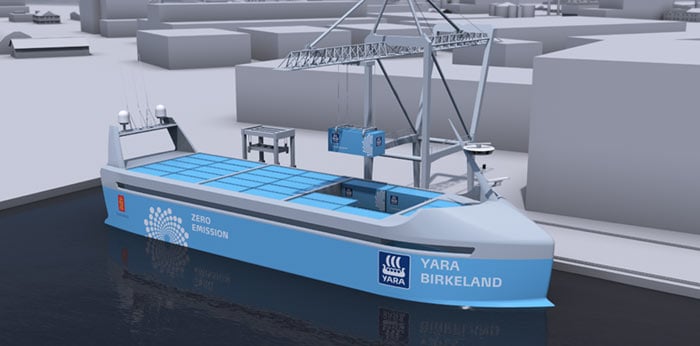For decades, the principle of “doing good for the world” has been the cornerstone of Norwegian foreign policy. However, with the announcement from YARA (a Norwegian Chemical Company) and Kongsberg (a long-established marine solutions company of Norway), the “doing good for the world” principle found its match in commerce.
Last October, Kongsberg, in collaboration with the Norwegian government and scientific institutes, launched the world’s first test site for autonomous shipping vessels at Trondheim Fjord. Only eight months after the site’s operations began, the “YARA Birkeland” project was born.
The YARA and Kongsberg partnership announced their plan to build world’s first fully-automated, fully electric-powered, and zero CO2-emitting feeder vessel. The project, named after YARA’s Founder, the famous scientist and innovator Kristian Birkeland, initially aims to completely cut CO2 emissions, for the loading and feeding parts of the container’s journey. While highly-innovative electric straddle carriers move containers to the loading site, electric-powered cranes will take care of the rest of the loading.
Watch a a video introducing this special vessel below:
The vessel plans to run as a manned carrier in the first phase of its operations, and by 2019, it plans to be operated by a remote operations center, which will direct the vessel throughout a set course. By 2020, it plans to continue its operations as a fully-autonomous carrier.
When it becomes operational, the project will save 40,000 truck journeys annually.
This amount is also expected to reduce CO2 emissions by 678 tonnes per year, and even electricity used to charge the ship’s batteries is planned to be generated almost exclusively from hydroelectric plants. “Every day, more than 100 diesel truck journeys are needed to transport products from YARA’s Porsgrunn plant to ports in Brevik and Larvik where we ship products to customers around the world,” Yara’s chief executive Svein Tore Holsether said in a statement.
Another advantage of electric feeders is they are 100% more sensitive to the fragile marine life within harbors, compared to their diesel engine-powered cousins. By reducing the amount of dumped ballast water to zero, the electric feeders will also eliminate the harmful organisms carried within the vessel’s ballast tanks. These organisms, due to their invasive nature, significantly threaten marine life.
- 219shares
- 149Facebook
- 67LinkedIn




